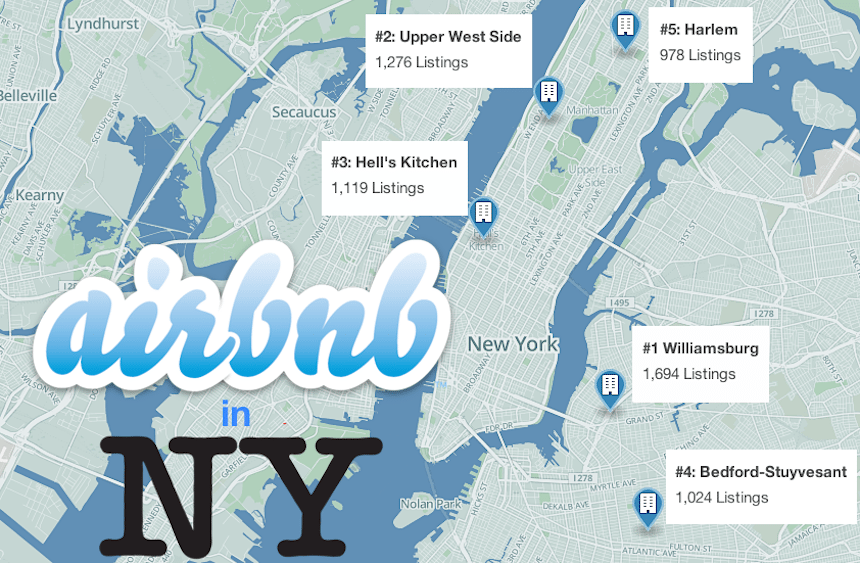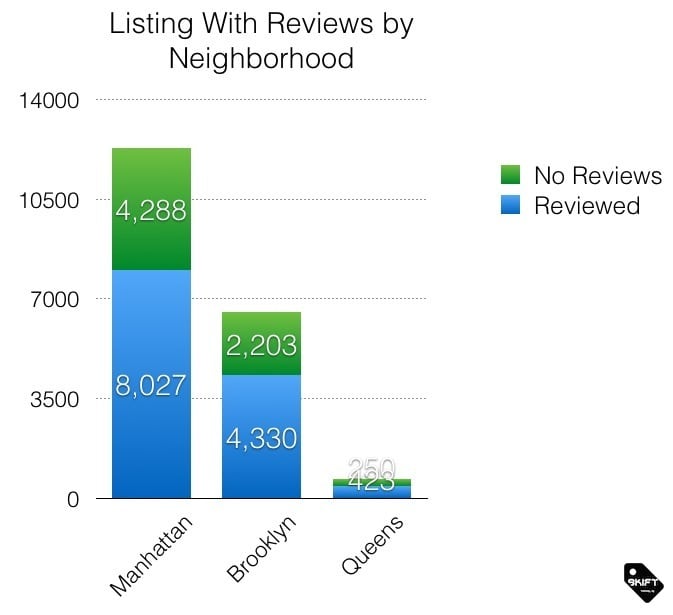Skift Take
Airbnb's business in New York is a fascinating look at how the sharing economy has evolved, as well as the challenges that remain ahead of it.
Editor’s Note: This is the first in a series of data dives into Airbnb’s listings in New York City. We believe Airbnb Vs. NYC is the defining fight of the sharing economy, and some understanding of how the platform is being used will help clear up the laws as they change. Part two here.
Airbnb versus New York City is one of the defining fights of the sharing economy.
It is so important that the highest profile sharing economy company is waging a three-pronged political, legal, and public relations battle in the city. The impending battle with the state Attorney General — court proceedings begin in late March — is easily one of the most important challenges Airbnb has faced in its six-year history.
The Attorney General and a host of other state and local politicians say many hosts on Airbnb are violating a state law that prohibits most short-term rentals of less than 30 days. They also share concerns that hosts aren’t paying their fair share of taxes.
Airbnb responds by claiming that its hosts are largely made up of people renting the home where they live, and doing so only occasionally. The company says it is too hard to police user activity and abiding by local laws, as well as restrictions placed on hosts by leases, condo associations, and co-op boards, is up to the individual users.
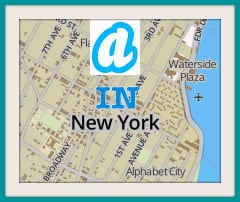
Yesterday, Airbnb responded to a list of questions from Skift about its users with the statement “87 percent of Airbnb hosts in New York share only the home in which they live.”
The company does not provide access to details about its hosts, how many listings they have, or occupancy levels. Its battle with the New York Attorney General is over a limited set of this information, specifically details related to the number of listings represented by hosts who are not staying in the apartment when a guest is present.
Airbnb told the Attorney General that compiling this data was too burdensome, so Skift decided to help out.
Skift turned to Connotate, a data extraction and monitoring firm. Using its tools, Connotate took a deep dive into Airbnb in New York City in January. “Understanding the usage patterns of a service is difficult when you can only see individual listings,” says Barry S. Graubart, Connotate’s Vice President of Product Strategy. “Analyzing a full month’s worth of listings for all of New York City provides a better understanding of how hosts are using the Airbnb marketplace service.”
We’ve always wanted to know: How popular are listings by hosts who rent their own homes when compared to all the inventory? Do the 87% of hosts also rent out other units that are not theirs? How many nights a year do their apartments add to Airbnb’s inventory? How much of the inventory on the site do the other 13% of hosts represent?
Below we crunch the numbers on hosts, number of listings, user reviews, and most popular neighborhoods in New York.
Hosts in New York City
As of January 31, there were 19,521 unique listings in New York City on Airbnb [see note about numbers at the end]. Behind those listings are 15,678 unique hosts who are renting houses, apartments, rooms, and shared spaces in the city.
These hosts can be split into two groups: Those with one listing on the site and those with more than one. It’s heavily weighted towards those with one with 88% having only one listing and 12% having two or more (13,828 vs. 1,850). This does not conflict greatly with Airbnb’s statement that 87% rent the place where they live, even if these is no direct correlation between “host” and “resident.”
It’s not the same story for Airbnb’s inventory in the city. 70% of the available inventory is represented by people who only have one listing, while 30% comes from users who have posted more than one listing. This is made up of a mix of either one listing owned or leased by the person listing it and one other unit, or people who are renting multiple spaces on behalf of themselves or others.
That 30% breaks down like this:
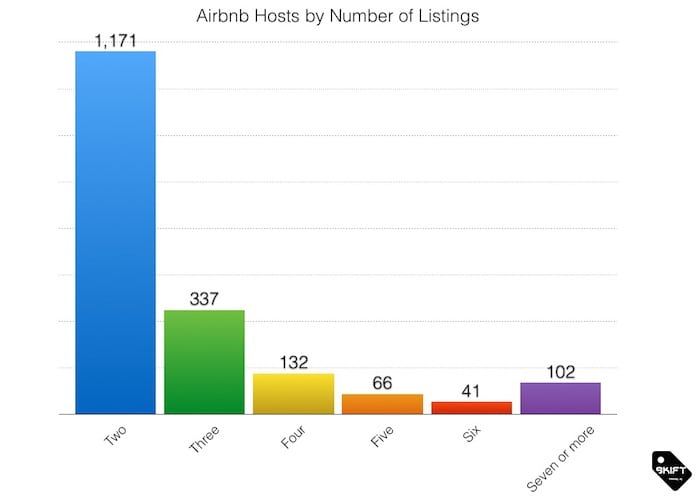
102 hosts have 7 or more listings on the site, representing a total of 1,237 available listings on the site.
Behind the Multiple Listings
The Attorney General’s office has stated that it is more concerned with people who are not present when the rental takes place and those who have multiple listings on the site, as opposed to a user who is renting a spare room.
Critics of Airbnb point to the prevalence of illegal hotels on the site. Although there are a number of hosts engaging in this behavior, Connotate’s research didn’t reveal this to be a widespread problem. Rather, there are dozens of hosts who have units spread across parts of the city, like the east side of Manhattan, or specific neighborhoods like Harlem or Greenpoint. In contrast to the freewheeling days of Toshi on the site, there are even some legal hotels using Airbnb as a platform, too.
The more prevalent issue is that, as we’ve seen in other cities, there are a number of hosts who have a handful of units that they manage for foreign investment firms, property owners, or friends. These hosts are a cross between apartment broker and hotel manager, shuttling between units to make sure guests have keys, clean sheets, and, if they’re lucky, toiletries.
They’re the type of user that Airbnb could better train with hotel veteran Chip Conley, who was hired in September.
Most Popular Room Type
Airbnb’s guests do not like sharing rooms with others. Almost to the point where it isn’t even worth including it as a housing type. The site has 449 listings for shared rooms — 2% of the listings on the site — but only 64% of those (289) have reviews. This is the lowest of all three room type categories.
“Private room,” which is in some cases — depending on zoning, and whether the host or another guest is present in another room — a legal type of room in New York, captures just a tick less than one-third of the types of rentals available on Airbnb.
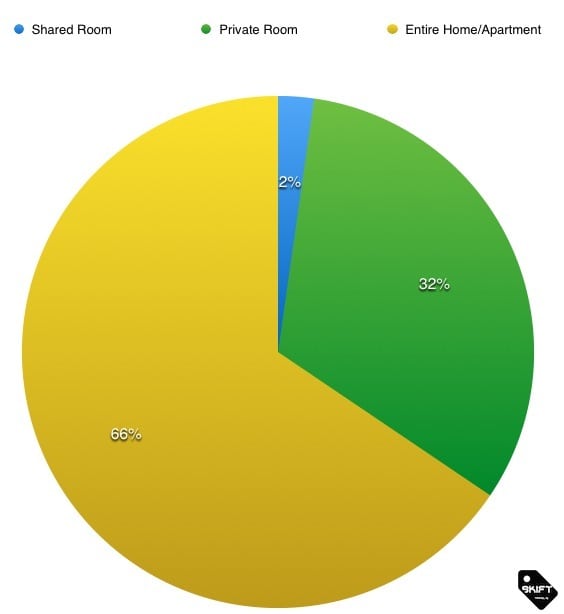
Two thirds of the listings that contain user reviews are for the “Entire home/apartment” room type (listings without reviews are slightly less, at 64%). Because of a New York State law regarding short-term housing, it is almost always illegal to rent a full apartment when the host is not present for less than 30 days.
As opposed to the types of Airbnb hosts promoted by the sharing lobbying group Peers — which works closely with Airbnb on policy issues — the vast majority of the platform’s hosts in New York appear to be people who are absent from their apartments or the apartments that they manage when guests appear.
We reported last year that at least half of the listings on Airbnb were by hosts that were breaking the law. From Connotate’s research, it appears that number is closer to two thirds.
Users and Booking Behavior
The best way to learn about guests is through the reviews they leave behind. Guest leave reviews to both praise or criticize a host, as well as create their own history on the site so that future hosts know about them. They also provide insight into whether or not rooms are full.
Airbnb doesn’t share details on how much of its inventory is used or what its occupancy levels are. Unlike a hotel that has all or nearly all of its rooms for sale every night, listings on Airbnb may not be available every night of the week. Or they are, and nobody is buying. One way to determine how busy the site is is through the volume of user reviews that guests leave behind.
Of the 19,521 listings that were available on Airbnb in January, 6,741 of them have zero reviews, which represents 35% of the listings on the site. An additional 2,336 only have one review, bringing the total of lightly-used listings on the site up to 46%.
The lack of interest in nearly half of New York City’s listings should be contrasted to the activity on the other half.
There are 85 listings that have over 100 guest reviews, the most popular one currently being a $99 private room on the Upper East Side, which has 174 reviews. In a way, this is the perfect Airbnb listing: It’s legal, people love it, and it is in a good neighborhood.
Contrast that listing with the properties managed by one host. Between the 29 listings managed by John and Lucy, guests have left an enthusiastic 890 reviews.
Most Popular Neighborhoods
Airbnb has argued that its most popular locations for listings are in neighborhoods with few hotel options. Connotate’s research demonstrates that the five neighborhoods with the most listings are also ones that have fewer hotel options than hotel-heavy areas like Midtown.
| Number of listings | Listings with reviews | Total reviews | |
|---|---|---|---|
| Williamsburg | 1,694 | 1,141 | 13,342 |
| Upper West Side | 1,276 | 853 | 8,812 |
| Harlem | 978 | 741 | 9,845 |
| Hell’s Kitchen | 1,119 | 713 | 11,257 |
| Bedford-Stuyvesant | 1,024 | 713 | 9,638 |
Still, Manhattan is the most popular destination by volume. It has 12,315 listings, 8,027 of those with reviews. There are ten neighborhoods that have more than 400 listings each.
| Neighborhood | Number of listings | Listings with reviews |
|---|---|---|
| Upper West Side | 1,276 | 853 |
| Harlem | 978 | 741 |
| Hell’s Kitchen | 1,119 | 713 |
| Upper East Side | 1,091 | 668 |
| Lower East Side | 726 | 524 |
| West Village | 730 | 494 |
| Chelsea | 699 | 482 |
| East Village | 659 | 474 |
| Midtown | 570 | 414 |
| Alphabet City | 447 | 355 |
Compare this to Brooklyn, which has 6,533 listings, 4,330 with reviews. Only five neighborhoods have more than 400 listings, despite their larger geographic size when compared with Manhattan. Queens has only 673 listings, 432 of those with reviews. The bulk of these are in Astoria.
Guests who stay in Manhattan are also more likely to review their stay than those in other parts of the city. The five neighborhoods with the most reviews per listing are all in Manhattan.
| Neighborhood | Number of listings | Listings with reviews | Total reviews | Average reviews per listing |
|---|---|---|---|---|
| Meatpacking District | 33 | 23 | 507 | 22.0 |
| Chinatown | 234 | 165 | 3,020 | 18.3 |
| Alphabet City | 447 | 355 | 6,129 | 17.3 |
| East Village | 659 | 474 | 8,039 | 17.0 |
| Midtown | 570 | 414 | 6,947 | 16.8 |
A Note About Numbers
Airbnb’s main New York City page says it has 34,020 listings spread between 60 neighborhoods. This is different than our total of under 20,000 listings. It appears that this discrepancy is due to Airbnb counting listings twice that are in overlapping neighborhoods. For instance, on the site all locations in the South Street Seaport area are also listed in the Financial District.
Read More: The 10 Airbnb Super-Hosts That Rule New York City
Dwell Newsletter
Get breaking news, analysis and data from the week’s most important stories about short-term rentals, vacation rentals, housing, and real estate.
Have a confidential tip for Skift? Get in touch
Photo credit: The five biggest neighborhoods for Airbnb are in parts of Brooklyn and Manhattan with few hotels. Skift / Mapbox
